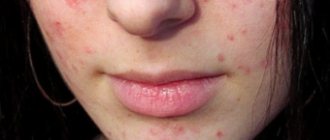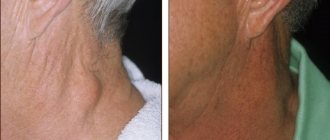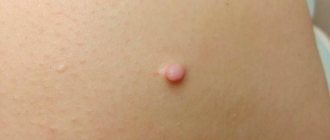A boil under the arm is an unpleasant problem from the point of view of pain and deterioration of the patient’s lifestyle. Regular rashes and pimples go away on their own, and the inflammatory process in the hair follicle has a long period of maturation and subsequent healing.
A lump under the arm is not an indicator of furunculosis. The disease is confirmed by further progress in stages and subsequent opening of a purulent formation. What to do if a boil appears and how to treat it? First, it is necessary to find out the root causes of its formation; symptomatic treatment is prescribed for them.
A lump under the arm is not an indicator of furunculosis
General concept of the disease
Boil is an infectious pathology of the skin, manifested by a pronounced inflammatory process with accumulated pus. The formation occurs in any area of the body covered with hair, so the area under the armpit is considered an ideal place.
A furuncle under the arm is a purulent inflammation of the hair follicle under the arm. Occurs against the background of increased sweating and immunodeficiency, with the addition of staphylococcal or streptococcal infections.
Diagnosis based on examination and tests. Symptoms: sharp pain, itching, red formations with purulent contents, swelling, fever.
Treatment is combined, surgical-conservative, with the use of antibiotics, immunomodulators
The appearance of a boil indicates an inflammatory process in the follicle, neighboring tissues or sebaceous glands. The pathological formation looks like a cone-shaped tubercle of skin with a necrotic core, surrounded by pus in the form of a black spot in the center.
Hidradenitis or a diffuse inflammatory process in the sweat gland often develops under the armpit, so it is important to exclude these diseases when diagnosing a boil.
For example, hidradenitis differs from a boil in the absence of a necrotic core and the deeper location of the pus. However, the causes and clinical picture of these diseases are similar.
Is it possible to squeeze out a boil?
When a boil occurs under the armpit, almost every person has an irresistible desire to squeeze out the lump. Theoretically, such a procedure will help get rid of pain and developmental symptoms. But in practice, it is impossible to squeeze out an immature abscess. It is possible to crush the inflamed follicle under the skin, this will lead to the spread of the bacterial pathogen through the blood in the human body. Often such actions become a predisposing factor to the appearance of multiple furunculosis throughout the body. The most dangerous results of self-squeezing or treatment are meningitis, sepsis, abscesses of internal organs and death.
Mature boils located under the arms are easier to squeeze out, but the risk of follicle rupture remains unchanged. Disclosure manipulation can be carried out by surgeons in a medical facility, subject to the rules of asepsis and antisepsis.
Self-squeezing, piercing, cutting is strictly prohibited.
Reasons for the development of a boil
The main reason for the development of the disease is the penetration of pathogenic microorganisms into injured skin.
Which doctor should I contact with a boil?
Boil is a purulent inflammatory formation that affects hair follicles.
Most often, the disease is caused by staphylococci or streptococci, which under normal conditions enter the microflora of the epithelium without causing any inconvenience. In addition to the ingress of bacteria, there are a number of factors that greatly increase the likelihood of developing furunculosis, such as:
- Weakened local and general immunity. In such cases, the body lacks antibodies, blood cells that protect against harmful microorganisms and viruses.
- Fasting or incomplete diet. A lack of vitamins, minerals and other beneficial substances leads to a decrease in resistance to infections.
- The presence of microscopic damage to the skin and contamination. Many people regularly cleanse their armpits of hair, which causes injury to the skin and weakens the protection against bacteria that accumulate due to poor hygiene and cause purulent formation.
- Impaired metabolism due to diabetes .
- Aggressive temperature influences. Hypothermia and overheating negatively affect the restoration processes in the epithelium and weaken local immunity.
- Increased sweating.
- Skin contact with synthetic clothing.
- The presence of chronic infectious pathologies and HIV.
Doctors have proven that boils under the armpit occur due to the use of deodorants or antiperspirants, the elements of which disrupt the functioning of the sweat and sebaceous glands. Such substances should only be used as a last resort, and not immediately after sports activities or taking a bath.
Stages of furunculosis
Symptoms of furunculosis depend on what stage of development the disease is at. The pathological process occurs in the same way in all people, but only a few know how to stop the inflammation and make the infiltrate resolve at the very beginning of its occurrence.
Stages of boil development:
- First day. Ostiofolliculitis develops - the skin around the hair follicle becomes dense, red and swollen. The person begins to feel a painful burning sensation under the armpit.
- Second or third day. The infiltrate increases to 3 cm in diameter. A purulent core begins to form inside it. The skin around the pathological lesion, which gradually matures, becomes hot. The affected area is very painful.
- Fourth to sixth days. The skin around the purulent infiltrate changes color to red-blue, in the center of the lesion it becomes thin and transparent, pus is visible underneath.
- Seventh to tenth day. When the abscess matures, the skin over the purulent core softens, and the purulent-necrotic masses on the surface come out. Within 24 hours, healthy tissue rejects the rod, after which healing begins.
The described process is relevant only for those cases that are not complicated in any way.
Clinical signs of an abscess under the arms
Due to the nature of the affected area, the symptoms of a boil are pronounced, so they are hard to miss. A boil under the arm causes discomfort to the patient with the following manifestations:
- Pain in the armpit that quickly increases, causing the patient to be unable to touch the affected area.
- An inflammatory reaction, for example, constant burning or severe itching at the site of infection. During the examination, a minor spot is revealed with a more pronounced color than the rest of the skin.
- The formation of swelling under the armpit with the gradual formation of a cone-shaped tubercle of scarlet color. Contact with such swelling is accompanied by pain.
- The appearance of a painful and pulsating necrotic rod with a black spot in the center and a white outline. Such dead tissue is surrounded by pus.
- Deterioration in general health, for example, increased temperature, aching joints, muscle pain and headache, weakness and drowsiness. In some cases, the lymph nodes in the neck and under the armpit become enlarged, painful to the touch and making it difficult to move the arm.
After opening the abscess and in the absence of complications, the patient’s condition returns to normal, the temperature drops, and the pain and swelling subside.
Symptoms of furunculosis in the armpit
- The appearance of a red bump rising under the surface of the skin, with an abscess in the center of the crater. As the purulent process increases, the crater tissue softens and an ulcer appears, in the center of which you can see a green rod.
- In the later stages, when the process is resolved - the rod leaves the crater, the discharge of pus and blood is observed. The appearance of two or more abscesses indicates that bacteria have entered the capillaries and lymphatic vessels of the axillary tissue.
- Throbbing pain in the armpit, which appears at rest, intensifies when moving the arm, forcing the patient to take a forced position - holding the arm without pressing it to the body.
- Enlarged axillary lymph nodes, feeling of heat in the axillary area
- Increased body temperature, headaches, weakness
Useful information on the topic:
- Diagnosis of surgical diseases
- Treatment of surgical diseases
- How is a consultation with a surgeon carried out?
- Examination by a surgeon
- Surgery - the science of internal medicine
- How is a surgeon's appointment carried out?
- Pediatric surgeon
- Removal of skin tumors
- Paid surgeon
Diagnosis
Diagnosis of an abscess is very difficult, since it is necessary to exclude similar diseases, for example, hidradenitis or deep trichophytosis. The first pathology affects the apocrine glands, in which a purulent inflammatory process develops.
Why can our articles be trusted?
We make health information clear, accessible and relevant.
- All articles are checked by practicing doctors.
- We take scientific literature and the latest research as a basis.
- We publish detailed articles that answer all questions.
Hidradenitis differs from boils in the absence of a necrotic core. Trichophytosis granuloma occurs on the head. When diagnosing this pathology, it is important to identify the patient’s contact with animals or the cause of the development of painful sensations with a purulent core.
How to treat a boil
A dermatologist treats boils.
The formation under the armpit is special in that it only occurs in areas where hair grows. Often the first symptoms of a boil are mistaken for irritation. It all starts with itching, hyperemia, swelling in the area of the hair follicle, after which an inflamed, purple-colored swelling appears that hurts when touched.
The swelling regularly increases, and after a few days the affected tissue becomes greenish. This is how the core of the abscess is formed. To diagnose a boil under the arm, you first need to seek help from a surgeon or dermatovenerologist, who should examine the affected area.
After this, a blood test is taken for antibodies to staphylococci. Moreover, the study is carried out several times, since the first results in almost all adults are normal.
What to do when it appears under the armpit
The occurrence of boils under the arms is associated with microtraumas and poor personal hygiene. The development of the disease occurs due to the entry into damaged tissues of Staphylococcus aureus, a pathogenic bacterium that is resistant to survival in the external environment. The bacterium, penetrating the tissue, is localized in the hair follicle and near the follicular space. An active growth in the number of the pathogen begins. A purulent inflammation forms, and the abscess looks like a round, reddish lump. Over time, a white dot forms in the center of the lump - a purulent-necrotic core. Local temperatures rise.
If such a formation is detected under the arm, a person should consult a doctor. Based on a diagnostic study, laboratory tests and examination by a specialist, a decision on step-by-step treatment will be made. Seeing a doctor is necessary for timely detection of possible complications - phlegmon, furunculosis, or multiple abscesses of internal organs.
If diagnostics and tests do not show the presence of pathological changes, the doctor will recommend topical home treatment for the boil.
Therapy at home consists of the use of ointments to accelerate the maturation of a boil under the arm, antibiotics (to suppress the activity of infection), and means for healing the skin after a breakthrough. Antiseptics are needed to prevent the spread of staphylococcus and the addition of a secondary infection. Alternative treatment is sometimes used in combination with traditional therapy.
In the normal course of the disease, in the absence of disturbances in the opening of the abscess and the outflow of pus, the boil goes away on its own. The main tasks of a person during the period of maturation of an abscess are to maintain hygiene in the axillary area, eliminate the risks of injury, and not use treatment methods that can aggravate the situation.
Treatment
The choice of therapeutic therapy is influenced by the stage of the disease. Self-medication leads to dangerous complications and hospitalization, so when the first clinical signs appear, you should immediately contact a specialist. Conservative treatment is used in the absence of signs of intoxication and at the initial stage of the pathology. This therapy stops the inflammatory process.
Self-medication is dangerous with complications!
Attention
Despite the fact that our articles are based on trusted sources and have been tested by practicing doctors, the same symptoms can be signs of different diseases, and the disease may not proceed according to the textbook.
Pros of seeing a doctor:
- Only a specialist will prescribe suitable medications.
- Recovery will be easier and faster.
- The doctor will monitor the course of the disease and help avoid complications.
find a doctor
Do not try to treat yourself - consult a specialist.
Ultraviolet irradiation is used to disinfect the surface of the skin and destroy harmful microorganisms. However, this type of physiotherapy must be used in combination with other therapeutic methods, otherwise there will not be a good result.
Along with the previous procedure, it is advisable to apply compresses several times a day.
With a boil, it is important that the hand does not move, since friction only aggravates the situation and intensifies the symptoms. To protect the boil from the mechanical impact of the upper limb, it is necessary to bandage the formation with a bandage. Antibacterial agents are the most effective method of conservative treatment, since tablets and injections act on the problem from the inside.
Causes of boils on the body
The appearance of a boil on the body is a sign of activation of staphylococci and streptococci.
For this, broad-spectrum antibiotics are used, and within a day after the first use of the drug, the patient’s condition improves. To make you feel better and relieve severe pain, painkillers are prescribed. Thanks to analgesics, the patient does not lose ability to work during the period of the disease.
Often, in a clinic, a boil is eliminated through surgery. The operation consists of the following stages:
- Injections of local anesthetic near the abscess for pain relief.
- Cutting the boil with a scalpel, followed by washing the wound to remove the purulent mass.
- Installation of special drainage to completely eliminate necrotic tissue.
- Applying saline bandage To prevent relapse, an antibacterial ointment is used.
If a serious skin defect occurs after surgery, stitches are applied.
Methods for safely treating armpit boils
The treatment tactics for boils depend on the course of the disease and are selected individually for each individual patient by the doctor after consultation. Depending on the complexity, a boil under the arm can be treated using special pharmaceutical ointments and solutions, and physiotherapy. Folk remedies are used in combination with traditional methods.
Review of effective ointments
Heparin ointment. Anticoagulant for local application. Prevents the development of thrombosis in blood vessels and has an effective anti-inflammatory effect. The active component of the drug, heparin, helps to cope with boils at the stage of its maturation. Benzocaine - reduces pain. Accelerates the process of abscess formation and its opening. Before use, you should make sure that there is no allergic reaction to the medication. Apply a thin layer to the damaged area of the skin under the armpit. The standard course of treatment is 14 days, but if there is no effectiveness, it is recommended to replace the ointment after 5-7 days of use.
Ichthyol ointment. The drug is intended to draw out pus from boils located under the armpits. The drug contains medicinal petroleum jelly and pure ichthyol. The local remedy has an effective anti-inflammatory, antipruritic, decongestant effect during treatment. The drug is applied in a thin layer to the inflammation site twice a day.
Ointments for treating boils under the arm have different functional effects. They are used to treat specific stages of maturation and are suitable exclusively for a specific phase.
Vishnevsky's liniment. The ointment is known for its effective healing effect in the treatment of skin diseases and wounds. Helps relieve inflammation under the arms, itching, swelling, and dries out weeping wounds. The drug contains castor oil, tar and xeroform, which help treat any skin damage. Vishnevsky ointment is applied to a gauze bandage and applied to the boil.
Need advice from an experienced doctor?
Get a doctor's consultation online. Ask your question right now.
Ask a free question
Levomekol. An effective antimicrobial agent. Helps prevent the spread of staphylococcal infections under the arms, inhibits bacterial activity, and prevents the addition of secondary invasions. Applying Levomekol to a boil promotes rapid healing of the wound without the risk of relapse of the disease. The ointment is applied to clean, dry skin, treatment is carried out for 1-1.5 weeks.
Elon. Antiseptic disinfectant based on plant components. Has a visible anti-inflammatory effect. The substance is intended exclusively for external use in adult patients. During treatment, the ointment is applied in a 2-3 cm strip to the affected area under the armpit, covered with a sterile bandage, it should be changed 1-2 times a day.
Baneocin. The drug has an active antimicrobial effect. The ointment contains 2 broad-spectrum antibiotics, which allows you to cope with the activity of the boil pathogen under the arm and prevent infection with other infections. The local remedy is applied 2-3 times a day, treatment is carried out for 1 week.
Physiotherapy
Physiotherapeutic methods of treatment are prescribed with the aim of developing a bacterial pathogen, increasing immune resistance and reducing signs of furunculosis in the axillary area. The main ways to get rid of boils are:
- Short-wave ultraviolet irradiation (SWUV). It has bactericidal properties, stimulates the immune system, improves metabolism in the affected tissues under the arms.
- Ultraviolet irradiation (UVR). The treatment relieves inflammation and promotes healing of damaged tissue in the axillary area.
- High-frequency therapy – stimulates defense mechanisms, provokes an immune response, promotes boil healing.
- Laser therapy. Reduces the inflammatory process. Treatment helps the body develop resistance to various pathogens. Stimulates the healing of damaged tissues.
- Magnetic therapy is a way to get rid of inflammatory processes and swelling. Has a positive effect on the functioning of local immunity.
- Dry heat. The method is intended for the treatment of boils under the arms in the early stages. Provokes ripening, reduces symptoms of suppuration.
- Ultrasound therapy improves blood microcirculation in the affected area, helps eliminate infiltration and cell regeneration.
- Electrophoresis. Increases blood flow in the damaged area under the arms, relieves pain, and promotes rapid resorption of boils.
A physiotherapy session is selected individually for each specific patient in accordance with the characteristics of his body and the course of the disease. Treatment can be monotherapy or included in a complex of procedures.
Traditional treatment
Traditional medicine is used as an auxiliary treatment. There are several proven recipes that will help eliminate the pain of the abscess and remove the boil under the armpit in a short time.
Recipe No. 1
Branches and cones of coniferous trees are boiled. They insist for some time. A gauze bandage is soaked in the prepared solution and applied to the affected area under the armpit for treatment. The top is secured with polyethylene. This compress eliminates pain and accelerates the maturation of the boil.
Recipe No. 2
Cabbage leaves are beaten to soften. The broken leaf is smeared with a small amount of natural honey. The compress is applied to the boil and wrapped in cloth. Leave for several hours. Treatment should be repeated until the contents of the abscess come out.
Recipe No. 3
For treatment, a quarter of a bar of laundry soap is crushed using a grater. The resulting chips are boiled in water until they acquire a thick consistency. The cooled product is applied to the affected armpit and left for several hours. The lotion on the boil is changed three times a day. Treatment is carried out until the abscess is opened.
Complications and consequences of an abscess
If a boil appears under the armpit, it is strictly forbidden to do the following:
- Squeeze or pop a boil at home. Because of this, the infection spreads and sepsis develops.
- Comb or cut off the inflamed area.
- Massage the skin surrounding the boil even in the final stages of the disease.
- Rub the boil, touch it with clothes, use deodorants or hard washcloths.
- Treat the affected area with brilliant green or iodine before visiting a doctor, as these agents mask the pathology.
- Continue self-medication at home if the formation does not go away within a few days.
In advanced cases, the inflammatory process spreads to deeper tissue structures. This leads to the formation of a carbuncle. A complicated pathological formation, in addition to the epidermis, affects adipose tissue along with the sebaceous glands, which significantly worsens the situation and the patient’s well-being.
Most often, the body is able to cope with a boil on its own, but the carbuncle can only be eliminated through surgery.
If the boil does not go away after a few days, then it is necessary to urgently consult a specialist, since the abscess causes complications that end in death. Lack of adequate treatment under the supervision of a doctor leads to the development of an abscess, phlegmon and blood poisoning.
What do boils look like?
When one large boil appears under a person's armpit, it is called a boil. If several such painful pimples occur, then we are talking about the development of furunculosis. New growths may look different. A boil that just appears is a dense subcutaneous node. Visually, it can be seen by inflamed, red skin.
After a few days, the size of the infiltrate changes, and a yellow dot appears in the center. This begins to form a purulent core. Gradually, the abscess takes on a cone-shaped shape. The skin above it becomes transparent, under it you can see a purulent-necrotic mass.
Furunculosis in the armpit can become chronic if treated incorrectly. This means that boils in the hairline area will form until the skin’s immune system gets stronger.
Disease prevention
To protect yourself from relapse of the disease, you should follow the recommendations:
- Perform daily hygiene activities and change clothes regularly. After heavy physical activity, it is imperative to take a shower.
- Avoid hair removal using traumatic methods. To do this, it is better to use special shaving products and high-quality razors with a sharp blade.
- Do not wear tight synthetic clothing that rubs and irritates the delicate epidermis.
- If irritation occurs, immediately treat the redness an antiseptic , such as hydrogen peroxide. You should not use iodine or brilliant green, as these drugs will only worsen the problem.
- Lead an active lifestyle with regular sports activities, stop smoking and drinking alcohol. Such activities will strengthen the immune system and improve resistance to pathogenic microorganisms.
- Add fruits, vegetables, herbal teas to your diet so that the body is regularly saturated with vitamins, minerals, coarse fibers and other nutrients.
- As a preventive measure, drink a course of brewer's yeast.
- If you are prone to boils, avoid black tea, cheeses, coffee, pickled foods and fried foods.
- Treat chronic pathologies, such as diabetes, or infectious processes in a timely manner.
- Avoid hypothermia or overheating.
- Do not use deodorants or antiperspirants after shaving under the arm, performing hygiene procedures, playing sports or performing heavy physical work.
- Do not self-medicate at home without contacting a specialist.
Correct implementation of all preventive recommendations will protect the body from the appearance of boils under the armpit and in other areas of the body.
Signs of the disease
Signs of chiryak formation are difficult not to see , since the growth of formation is accompanied by inconvenience and high temperature.
- The formation covers the entire hair follicle, including the sweat gland and connective tissue. During the period of formation, collagen lesions appear, which are destroyed, like plastic fibers.
- The formation is subject to regular damage. This place hurts a lot, in particular during the formation of a boil. Therapy for the formation is determined by the level of its growth.
- When education occurs, it is important to follow the rules of personal hygiene. The source of damage should not come into contact with clothing, which irritates the skin. You need to give up deodorants. The source of infection must be regularly treated with creams and certain compounds. In severe cases of furunculosis, only surgery is necessary.
Why and why do abscesses appear in this particular place: 10 reasons
The activity of Staphylococcus aureus is what causes boils to appear in the armpit, as well as in other places on the body or face.
Normally, the activity of this microbe is suppressed by the immune system, but the protection is weakened if:
- Do not wash - water procedures wash away excess bacteria from the skin; in their absence, staphylococcus multiplies faster.
- Do not wash off deodorant and other cosmetics from your armpits before going to bed. Most products clog pores, which prevents toxins from being released through the skin.
- Washing too often. If you take a shower and rub your body with a washcloth more than 2 times a day, the protective fat layer will be washed off, the skin will crack, and microbes can easily crawl into the resulting “gaps in the defense.”
- Get sick. Systemic diseases, both acute and chronic, weaken the immune system, which causes bacterial skin rashes.
- Shave without treating the tool and skin with an antiseptic. During the procedure, the top layer of skin is cut off from the hair, which leads to the formation of microtraumas.
- Do waxing or sugaring in unsanitary conditions. In this case, the hair is pulled out by the roots, and infection easily penetrates into the empty hair follicles.
- Giving your towels, razor or deodorant to another person. If people live in the same apartment, it is not a fact that their staphylococci will get along with each other.
- Be nervous. Psychosomatics increases the risk of boils, since nervous tension weakens the immune system.
- Wear synthetic clothing. It’s even worse if things crash into the body. Sweat is a favorable environment for the proliferation of staphylococcus. Cotton underwear will absorb it, synthetics will not.
- Be overweight. Folds of fat create additional friction when moving. This injures the skin, which increases the activity of staphylococcus.
Treatment of lymph nodes
Treatment of lymphadenopathy of the axillary lymph nodes consists of selecting the correct etiotropic and pathogenetic therapy. The main thing is to remember that patients are strictly prohibited from attempting to independently eliminate this manifestation of the inflammatory reaction.
As a rule, all treatment is based on the elimination of the inflammatory focus, which caused the development of axillary lymphadenitis. Often, a course of antibacterial therapy or a number of anti-inflammatory drugs are prescribed for this. In addition, it is advisable to use compresses with Dimexide, immunomodulating drugs and a course of physiotherapeutic procedures, which will contribute to the overall strengthening of the body.
If a malignant process develops with concomitant lymphadenitis, the patient is advised to undergo a course of chemotherapy or surgical treatment.











